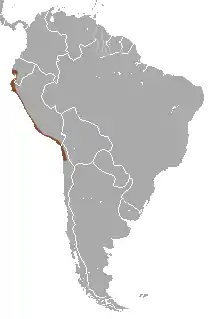Smoky bat
The smoky bat (Amorphochilus schnablii) is a species of bat in the family Furipteridae. It is monotypic within the genus Amorphochilus. Its natural habitat is rocky shores. It is threatened by habitat loss. This bat is also called the thumbless bat because its thumb is partly enclosed in its wing; this common name is also applied to another species, Furipterus horrens. This species lives in western Peru, western Ecuador, Puna island (Ecuador) and northern Chile. These bats can be found in groups up to 300 bats. In 2013, Bat Conservation International listed this species as one of the 35 species of its worldwide priority list of conservation.[2] The Smoky Bat is known to be exclusive to neotropical distribution, especially in Central American regions. It is also known that they do not leave their habitat until very dark out. The Smoky Bat also insectivores animals that like to fly very close to the ground to catch their prey. They also like to live in areas that are very hidden, such as small crevices (Duda, R., Dalapicolla, J., & Costa, L. P. (2012).
| Smoky bat | |
|---|---|
 | |
| Scientific classification | |
| Kingdom: | Animalia |
| Phylum: | Chordata |
| Class: | Mammalia |
| Order: | Chiroptera |
| Family: | Furipteridae |
| Genus: | Amorphochilus Peters, 1877 |
| Species: | A. schnablii |
| Binomial name | |
| Amorphochilus schnablii Peters, 1877 | |
 | |
Gallery
 Smoky Bat Wings Outstretched
Smoky Bat Wings Outstretched
References
- Velazco, P.; Huamani, L.; Cadenillas, R. (2015). "Amorphochilus schnablii". The IUCN Red List of Threatened Species. 2015: e.T1154A22070889. doi:10.2305/IUCN.UK.2015-4.RLTS.T1154A22070889.en.
- "Annual Report 2013-2014" (PDF). batcon.org. Bat Conservation International. August 2014. Archived from the original (PDF) on July 7, 2017. Retrieved May 1, 2017.

